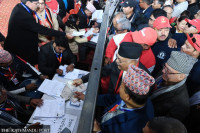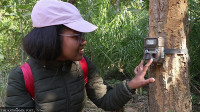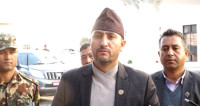Nepal on Thursday recorded 29 new Covid-19 cases taking the national tally to 456.
The country also reported its third Covid-19 death on Thursday.
A 41-year-old man of Madane Rural Municipality-6 of Gulmi who had tested positive for the virus on Monday, died this morning. He was admitted to Crimson Hospital in Rupandehi.
The Health Ministry, in a statement on Thursday night, confirmed three new cases— two in Banke district and another in Kapilvastu.
“Samples of a 32-year-old man and 42-year-old woman from Banke and 19-year-old man from Kapilvastu came positive for coronavirus,” said the ministry in a statement. “The health condition of all the patients are normal and they are in contact with medical personnel.”
Earlier in the morning, the ministry had confrimed 17 new cases and in the afternoon nine new cases were detected in Jhapa and Rupandehi.
The virus has already spread to 38 districts in the country.
With the authorities expanding testing, more cases are being reported from across the country.
The government has anticipated an exponential rise in Covid-19 cases throughout the country—1,000 within a week and around 2,000 in 10 days.
Banke has so far reported 101 cases, the highest in the country. The number of cases in Parsa district is 91. Sixty cases have been reported in Kapilvastu, 35 in Jhapa, 33 in Udayapur, along with 29 cases in Rupandehi.
Rautahat has reported 22 cases while Kathmandu has reported 10. Nine cases have been reported in Dhanusa.
Seven cases have now been reported from Dhankuta.
Similarly, Sarlahi has reported five cases while Kailali, Morang, Dang and Bara have reported four cases each, with three cases each from Chitwan, Sunsari, Bhaktapur, Dhading and Mahottari. Baglung, Makwanpur, Bardiya, Nawalparasi (West) and Nawalparasi (East) have reported two cases each.
Similarly, Khotang, Dailekh, Ramechhap, Lalitpur, Sindhuli, Lamjung, Gulmi, Bhojpur, Saptari, Siraha, Kanchanpur, Kavre and Sindhupalchok have reported one Covid-19 case each.
According to the Health Ministry, four patients were discharged from the Teku hospital, which takes the total number of discharged patients to 49. However, three patients have been readmitted into isolation after they retested positive for the coronavirus.
Frequently asked questions about the coronavirus outbreak
UPDATED as of September 22, 2020
What is Covid-19?
Covid-19, short for coronavirus disease, is an illness caused by the coronavirus SARS-CoV-2, short for severe acute respiratory syndrome coronavirus 2. Common symptoms of the disease include fever, dry cough, fatigue, shortness of breath and breathing difficulties. In severe cases, the infection can cause pneumonia, severe acute respiratory syndrome, kidney failure and even death.
How contagious is Covid-19?
Covid-19 can spread easily from person to person, especially in enclosed spaces. The virus can travel through the air in respiratory droplets produced when a sick person breathes, talks, coughs or sneezes. As the virus can also survive on plastic and steel surfaces for up to 72 hours and on cardboard for up to 24 hours, any contact with such surfaces can also spread the virus. Symptoms take between two to 14 days to appear, during which time the carrier is believed to be contagious.
Where did the virus come from?
The virus was first identified in Wuhan, China in late December. The coronavirus is a large family of viruses that is responsible for everything from the common cold to Middle East Respiratory Syndrome (MERS) and Severe Acute Respiratory Syndrome (SARS). After an initial outbreak in Wuhan that spread across Hubei province, eventually infecting over 80,000 and killing more than 3,000, new infection rates in mainland China have dropped. However, the disease has since spread across the world at an alarming rate.
What is the current status of Covid-19?
The World Health Organisation has called the ongoing outbreak a “pandemic” and urged countries across the world to take precautionary measures. Covid-19 has spread to 213 countries and territories around the world and infected more than 31,405,983 people with 967,505 deaths and 22,990,260 recoveries. In South Asia, India has reported the highest number of infections at 5,557,573 with 88,943 deaths. While Pakistan has reported 306,304 confirmed cases with 6,420 deaths. Nepal has so far reported 65,276 cases with 427 deaths.
How dangerous is the disease?
The mortality rate for Covid-19 is estimated to be 3.6 percent, but new studies have put the rate slightly higher at 5.7 percent. Although Covid-19 is not too dangerous to young healthy people, older individuals and those with immune-compromised systems are at greater risk of death. People with chronic medical conditions like heart disease, diabetes and lung disease, or those who’ve recently undergone serious medical procedures, are also at risk.
How do I keep myself safe?
The WHO advises that the most important thing you can do is wash your hands frequently with soap and water for at least 20 seconds or use hand sanitizers with at least 60 percent alcohol content. Avoid touching your eyes, nose and mouth with unclean hands. Clean and disinfect frequently used surfaces like your computers and phones. Avoid large crowds of people. Seek medical attention if symptoms persist for longer than a few days.
Is it time to panic?
No. The government has imposed a lockdown to limit the spread of the virus. There is no need to begin stockpiling food, cooking gas or hand sanitizers. However, it is always prudent to take sensible precautions like the ones identified above.
.jpg&w=900&height=601)




 18.12°C Kathmandu
18.12°C Kathmandu














